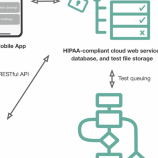
Articles
-
Jul 27, 2024 |
nature.com | Helen M. Bronte-Stewart |Paul Schmiedmayer |Shreesh Karjagi |Vishnu Ravi |Laura Parisi |Kevin B. Wilkins | +3 more
People with Parkinson’s disease (PWP) face critical challenges, including lack of access to neurological care, inadequate measurement and communication of motor symptoms, and suboptimal medication management and compliance. We have developed QDG-Care: a comprehensive connected care platform for Parkinson’s disease (PD) that delivers validated, quantitative metrics of all motor signs in PD in real time, monitors the effects of adjusting therapy and medication adherence and is accessible in the electronic health record. In this article, we describe the design and engineering of all components of QDG-Care, including the development and utility of the QDG Mobility and Tremor Severity Scores. We present the preliminary results and insights from an at-home trial using QDG-Care. QDG technology has enormous potential to improve access to, equity of, and quality of care for PWP, and improve compliance with complex time-critical medication regimens. It will enable rapid “Go-NoGo” decisions for new therapeutics by providing high-resolution data that require fewer participants at lower cost and allow more diverse recruitment.
-
Dec 4, 2023 |
nature.com | Jose Maldonado |Kyle P. O’Sullivan |Helen M. Bronte-Stewart |Brian Rutt |Jaimie M. Henderson |Nancy Temkin | +10 more
Converging evidence indicates that impairments in executive function and information-processing speed limit quality of life and social reentry after moderate-to-severe traumatic brain injury (msTBI). These deficits reflect dysfunction of frontostriatal networks for which the central lateral (CL) nucleus of the thalamus is a critical node. The primary objective of this feasibility study was to test the safety and efficacy of deep brain stimulation within the CL and the associated medial dorsal tegmental (CL/DTTm) tract. Six participants with msTBI, who were between 3 and 18 years post-injury, underwent surgery with electrode placement guided by imaging and subject-specific biophysical modeling to predict activation of the CL/DTTm tract. The primary efficacy measure was improvement in executive control indexed by processing speed on part B of the trail-making test. All six participants were safely implanted. Five participants completed the study and one was withdrawn for protocol non-compliance. Processing speed on part B of the trail-making test improved 15% to 52% from baseline, exceeding the 10% benchmark for improvement in all five cases. CL/DTTm deep brain stimulation can be safely applied and may improve executive control in patients with msTBI who are in the chronic phase of recovery. ClinicalTrials.gov identifier: NCT02881151 . A phase 1 feasibility trial shows that bilateral deep brain stimulation within the central lateral thalamus can be safely applied and is associated with improved executive control.
Try JournoFinder For Free
Search and contact over 1M+ journalist profiles, browse 100M+ articles, and unlock powerful PR tools.
Start Your 7-Day Free Trial →